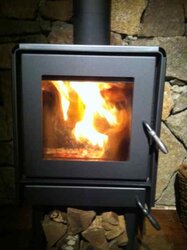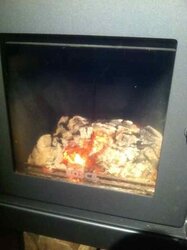Hello,
I live in southern Maine and we installed a wood stove this summer, so that we could have supplemental heat this winter. After a few weeks of obsessing
over my fires, I have learned how to make and keep a nice, hot fire. The only problem is that my burns only last between one and three hours.
Stove - Bosca Limit 450. Freestanding stove with 47,600 BTU's. Ash bin for quick lighting, glass front (for me to obsess over flame color), wood storage underneath.
Wood - Bark-less "Naked Wood" hardwood. I was going to include the types of hardwood, but their website is under construction.
So, I am at odds because most of what I have seen online says to make small, hot fires to 1) reduce the amount of pollution and 2) get the most from your wood. Once I get a nice bed of coals, and I start to put in bigger logs, I can only fit about four medium sized logs (or three really big ones) since my stove's fire box is small - only 16 and 1/2 inches wide (the wood is "16-ish"). Some of my logs have to squeeze in diagonally on top. So ... I put the logs in, open the damper for about 3 to five minutes, and then choke it down to about half. If I do this, I get vivid, bright orange flames and the logs are burnt in about an hour - then the coals burn down in about another hour. The stove, when operated this way, starts at about 350 degrees, gets up to about 425 at peek burn, and then cools to 325 as the coals cook down. Again, I get about two hours.
But ... my 76 year old neighbor, who's been burning wood almost as long, tells me to do the exact opposite - load up the stove and then choke it down to nothing. I have a strong feeling this isn't the right way, but I wanted to see if I could get a longer burn time. When I do this (choke the fire down immediately) my flames are blue-ish purple, and appear to hover about an inch above the logs. The only thing is that since the damper is almost closed, the stove gets super hot, and the logs almost appear to vaporize - they don't burn like normal, and the whole load just kind of vaporizes and turns to charcoal in about an hour.
So, to get my longest burns ... I put in as much wood as I can (about 4 logs), choke it down to about halfway, once I see bright orange flames, choke it down to about a quarter once things get really cooking, and then open the damper all the way, once I'm down to large pieces of charcoal (to cook them down to smaller pieces). If I do this, I get three hours of burn time - two hours of fire, and one hour of charcoal burning down. Is this really pathetic, or is it how things have to go for a stove with a smaller fire box? Some additional questions ...
1) After I have a nice bed of coals, whats the best way to load the wood - should I leave gaps for air or not? My neighbor says no.
2) I have read that the "ideal" temperature for clean burns is between 400 and 600 degrees. But, if I am only loading 4 pieces of wood, is this still the case?
3) I could definitely fit more logs - probably about 6 total, but I don't know how much to fill the fire box. I currently leave it about half to three-quarters full (from top to bottom).
I have included two pictures ...
(1) The stove during a hot burn - 4 logs, 400 degrees, damper half way closed.
(2) The stove after two hours - down to charcoal, 275 degrees.
Sorry for the long post, but appreciate any help!
Thanks,
Mark in Maine
I live in southern Maine and we installed a wood stove this summer, so that we could have supplemental heat this winter. After a few weeks of obsessing
over my fires, I have learned how to make and keep a nice, hot fire. The only problem is that my burns only last between one and three hours.
Stove - Bosca Limit 450. Freestanding stove with 47,600 BTU's. Ash bin for quick lighting, glass front (for me to obsess over flame color), wood storage underneath.
Wood - Bark-less "Naked Wood" hardwood. I was going to include the types of hardwood, but their website is under construction.
So, I am at odds because most of what I have seen online says to make small, hot fires to 1) reduce the amount of pollution and 2) get the most from your wood. Once I get a nice bed of coals, and I start to put in bigger logs, I can only fit about four medium sized logs (or three really big ones) since my stove's fire box is small - only 16 and 1/2 inches wide (the wood is "16-ish"). Some of my logs have to squeeze in diagonally on top. So ... I put the logs in, open the damper for about 3 to five minutes, and then choke it down to about half. If I do this, I get vivid, bright orange flames and the logs are burnt in about an hour - then the coals burn down in about another hour. The stove, when operated this way, starts at about 350 degrees, gets up to about 425 at peek burn, and then cools to 325 as the coals cook down. Again, I get about two hours.
But ... my 76 year old neighbor, who's been burning wood almost as long, tells me to do the exact opposite - load up the stove and then choke it down to nothing. I have a strong feeling this isn't the right way, but I wanted to see if I could get a longer burn time. When I do this (choke the fire down immediately) my flames are blue-ish purple, and appear to hover about an inch above the logs. The only thing is that since the damper is almost closed, the stove gets super hot, and the logs almost appear to vaporize - they don't burn like normal, and the whole load just kind of vaporizes and turns to charcoal in about an hour.
So, to get my longest burns ... I put in as much wood as I can (about 4 logs), choke it down to about halfway, once I see bright orange flames, choke it down to about a quarter once things get really cooking, and then open the damper all the way, once I'm down to large pieces of charcoal (to cook them down to smaller pieces). If I do this, I get three hours of burn time - two hours of fire, and one hour of charcoal burning down. Is this really pathetic, or is it how things have to go for a stove with a smaller fire box? Some additional questions ...
1) After I have a nice bed of coals, whats the best way to load the wood - should I leave gaps for air or not? My neighbor says no.
2) I have read that the "ideal" temperature for clean burns is between 400 and 600 degrees. But, if I am only loading 4 pieces of wood, is this still the case?
3) I could definitely fit more logs - probably about 6 total, but I don't know how much to fill the fire box. I currently leave it about half to three-quarters full (from top to bottom).
I have included two pictures ...
(1) The stove during a hot burn - 4 logs, 400 degrees, damper half way closed.
(2) The stove after two hours - down to charcoal, 275 degrees.
Sorry for the long post, but appreciate any help!
Thanks,
Mark in Maine





 ! Yes, I'm not too far from that but his way of burning is the old way and it did not work good in the old days either. Certainly it will not work in today's stoves.
! Yes, I'm not too far from that but his way of burning is the old way and it did not work good in the old days either. Certainly it will not work in today's stoves.